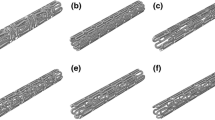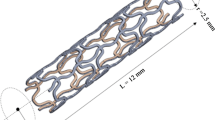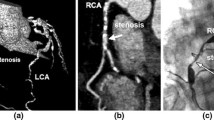Abstract
Balloon angioplasty with stenting is a well-established interventional procedure to treat stenotic arteries. Despite recent advances such as drug eluting stents, clinical studies suggest that stent design is linked to vascular injury. Additionally, dilation of the medical devices may trigger pathological responses such as growth and migration of vascular smooth cells, and may be a potent stimulus for neointimal hyperplasia. The purpose of this study is to experimentally investigate the mechanical characteristics of the transient expansion of six commercially available balloon-expandable stent systems, and to develop a robust finite element model based on the obtained experimental results. To reproduce the inflation of stent systems as in clinical practice, a pneumatic–hydraulic experimental setup is built, able to record loads and deformations. Characteristic pressure–diameter diagrams for the balloon-expandable stents and the detached balloons are experimentally obtained. Additionally, typical measures such as the burst opening pressure, the maximum dog-boning and foreshortening, and the elastic recoil are determined. The adopted constitutive models account for elastoplastic deformation of the stent, and for the nonlinear and anisotropic behavior of the balloon. The employed contact algorithm, based on a C 2-continuous surface parametrization, efficiently simulates the interaction of the balloon and stent. The computational model is able to successfully capture the experimentally observed deformation mechanisms. Overall, the numerical results are in satisfactory agreement with experimental data.












Similar content being viewed by others
References
Allender, St., P. Scarborough, V. Peto, M. Rayner, J. Leal, R. Luengo-Fernandez, and A. Gray. European Cardiovascular Disease Statistics, 2008 Edition. British Heart Foundation Health Promotion Research Group and Health Economic Research Centre, Department of Public Health, University of Oxford, 2008. www.heartstats.org
American Society for Metals International Handbook Committee. Metals Handbook. OH: ASM International, 1999.
Auer M., Stollberger R., Regitnig P., Ebner F., Holzapfel G. A. (2008) A methodology to study the morphologic changes in lesions during in vitro angioplasty using MRI and image processing. Med. Image Anal. 12:163–173
Barragan P., Rieu R., Garitey V., Roquebert P. O., Sainsous J., Silvestri M., Bayet G. (2000) Elastic recoil of coronary stents: a comparative analysis. Catheter Cardiovasc. Interv. 50:112–119
Brauer H., Stolpmann J., Hallmann H., Erbel R., Fischer A. (1999) Measurement and numerical simulation of the dilatation behaviour of coronary stents. Mat.-wiss. u. Werkstofftechn. 30:876–885
Carrozza J. P., Kuntz R. E., Levine M. J., Pomerantz R. M., Fishman R. F., Mansour M., Gibson C. M., Senerchia C. C., Diver D. J., Safian R. D. et al. (1992) Angiographic and clinical outcome of intracoronary stenting: immediate and long-term results from a large single-center experience. J. Am. Coll. Cardiol. 20:328–337
David Chua S. N., Mac Donald B. J., Hashmi M. S. J. (2003) Finite element simulation of stent and balloon interaction. J. Mat. Proc. Techn. 143–144:591–597
Degertekin M., Regar E., Tanabe K., Smits P. C., van der Giessen W. J., Carlier S. G., de Feyter P., Vos J., Foley D. P., Ligthart J. M., Popma J. J., Serruys P. W. (2003) Sirolimus-eluting stent for treatment of complex in-stent restenosis: the first clinical experience. J. Am. Coll. Cardiol. 41:184–189
Debeule M., Mortier P., Van Impe R., Verhegghe B., Segers P., Verdonck P. (2007) Plasticity in the mechanical behaviour of cardiovascular stents during stent preparation (crimping) and placement (expansion). Key Eng. Mater. 340–341:847–852
Debeule M., Van Impe R., Verhegghe B., Segers P., Verdonck P. (2006) Finite element analysis and stent design: Reduction of dogboning. Technol. Health Care 14:233–241
Donnelly E. W., Bruzzi M. S., Connolley T., McHugh P. E. (2007) Finite element comparison of performance related characteristics of balloon expandable stents. Comput. Meth. Biomech. Biomed. Eng. 10:103–110
Duda S. H., Wiskirchen J., Tepe G., Bitzer M., Kaulich T. W., Stoeckel D., Claussen C. D. (2000) Physical properties of endovascular stents: an experimental comparison. J. Vasc. Interv. Radiol. 11:645–654
Dumoulin C., Cochelin B. (2000) Mechanical behaviour modelling of balloon-expandable stents. J. Biomech. 33:1461–1470
Edelman E. R., Rogers C. R. (1998) Pathobiologic responses to stenting. Am. J. Cardiol. 81:4E–6E
El-Abbasi N., Meguid S. A., Czekanski A. (2001) On the modelling of smooth contact surfaces using cubic splines. Int. J. Numer. Meth. Eng. 50:953–967
Etave F., Finet G., Boivin M., Boyer J. C., Rioufol G., Thollet G. (2001) Mechanical properties of coronary stents determined by using finite element analysis. J. Biomech. 34:1065–75
Farb A., Sangiorgi G., Carter A. J., Walley V. M., Edwards W. D., Schwartz R. S., Virmani R. (1999) Pathology of acute and chronic coronary stenting in humans. Circulation 99:44–52
Fattori R., Piva T. (2003) Drug-eluting stents in vascular intervention. Lancet 361:247–249
Hoffmann R., Mintz G. S., Dussaillant G. R., Popma J. J., Pichard A. D., Satler L. F., Kent K. M., Griffin J., Leon M. B. (1996) Patterns and mechanisms of in-stent restenosis. A serial intravascular ultrasound study. Circulation 94:1247–1254
Hoffmann R., Mintz G. S., Mehran R., Kent K. M., Pichard A. D., Satler L. F., Leon M. B. (1999) Tissue proliferation within and surrounding Palmaz-Schatz stents is dependent on the aggressiveness of stent implanation technique. Am. J. Cardiol. 83:1170–1174
Hoher M., Wohrle J., Grebe O. C., Kochs M., Osterhues H. H., Hombach V., Buchwald A. B. (1999) A randomized trial of elective stenting after balloon recanalization of chronic total occlusions. J. Am. Coll. Cardiol. 34:722–729
Holzapfel G. A. (2000) Nonlinear Solid Mechanics. A Continuum Approach for Engineering. John Wiley & Sons, Chichester
Holzapfel G. A., Gasser T. C., Ogden R. W. (2000) A new constitutive framework for arterial wall mechanics and a comparative study of material models. J. Elasticity 61:1–48
Holzapfel G. A., Stadler M., Gasser T. C. (2005) Changes in the mechanical environment of stenotic arteries during interaction with stents: computational assessment of parametric stent design. J. Biomech. Eng. 127:166–180
Ibrahimbegović A., Al Mikdad M. (1998) Finite rotations in dynamics of beams and implicit time-stepping schemes. Int. J. Numer. Meth. Eng. 66:781–814
Iijima R., Mehilli J., Schömig A., Kastrati A. (2006) Clinical evidence on polymer-based sirolimus and paclitaxel eluting stents. Minerva Cardioangiol. 54:539–555
Kiousis, D. E., T. C. Gasser, and G. A. Holzapfel. Smooth contact strategies with emphasis on the modeling of balloon angioplasty with stenting. Int. J. Numer. Meth. Eng. 75:826–855, 2008
Kiousis D. E., Gasser T. C., Holzapfel G. A. (2007) A numerical model to study the interaction of vascular stents with human atherosclerotic lesions. Ann. Biomed. Eng. 35:1857–1869
König A., Schiele T. M., Rieber J., Theisen K., Mudra H., Klauss V. (2002) Influence of stent design and deployment technique on neointima formation and vascular remodeling. Z. Kardiol. 91:98–102
Kornowski R., Hong M. K., Tio F. O., Bramwell O., Wu H., Leon M. B. (1998) In-stent restenosis: contributions of inflammatory responses and arterial injury to neointimal hyperplasia. J. Am. Coll. Cardiol. 31:224–230
Lally C., Dolan F., Prendergast P. J. (2005) Cardiovascular stent design and vessel stresses: a finite element analysis. J. Biomech. 38:1574–1581
Liang D. K., Yang D. Z., Qi M., Wang W. Q. (2005) Finite element analysis of the implementation of a balloon expandable stent in a stenosed artery. Int. J. Cardiol. 104:314–318
McGarry J. P., O’Donnell B. P., McHugh P. E., McGarry J. G. (2004) Analysis of the mechanical performance of a cardiovascular stent design based on micromechanical modelling. Comp. Mater. Sci. 31:421–438
McLean D. R., Eiger N. L. (2002) Stent design: implications for restenosis. Rev. Cardiovas. Med. 3:16–22
Migliavacca F., Petrini L., Colombo M., Auricchio F., Pietrabissa R. (2002) Mechanical behavior of coronary stents investigated through the finite element method. J. Biomech. 35:803–811
Migliavacca F., Petrini L., Montanari V., Quagliana I., Auricchio F., Dubini G. (2005) A predictive study of the mechanical behaviour of coronary stents by computer modelling. Med. Eng. Phys. 27:13–18
Morton A. C., Crossman D., Gunn J. (2004) The influence of physical stent parameters upon restenosis. Pathol. Biol. (Paris) 52:196–205
Moses J. W., Leon M. B., Popma J. J., Fitzgerald P. J., Holmes D. R., O’Shaughnessy C., Caputo R. P., Kereiakes D. J., Williams D. O., Teirstein P. S., Jaeger J. L., Kuntz R. E. (2003) SIRIUS Investigators. Sirolimus-eluting stents versus standard stents in patients with stenosis in a native coronary artery. N. Engl. J. Med. 349:1315–1323
Nikkari S. T., Clowes A. W. (1994) Restenosis after vascular reconstruction. Ann. Med. 26:95–100
Olbrich T., Murray A. (2001) Assessment of computer-controlled inflation/deflation for determining the properties of PTCA balloon catheters with pressure–volume curves. Physiol. Meas. 22:299–308
Ormiston J. A., Dixon S. R., Webster M. W., Ruygrok P. N., Stewart J. T., Minchington I., West T. (2000) Stent longitudinal flexibility: a comparison of 13 stent designs before and after balloon expansion. Catheter Cardiovasc. Interv. 50:120–124
Padmanabhan V., Laursen T. A. (2001) A framework for development of surface smoothing procedures in large deformation frictional contact analysis. Finite Elem. Anal. Des. 37:173–198
Piegel L. A., Tiller W. (1997) The NURBS Book 2nd edition. Springer-Verlag, New York
Rieu R., Barragan P., Masson C., Fuseri J., Garitey V., Silvestri M., Roquebert P., Sainsous J. (1999) Radial force of coronary stents: a comparative analysis. Catheter Cardiovasc. Interv. 46:380–391
Rogers C., Edelman E. R. (1995) Endovascular stent design dictates experimental restenosis and thrombosis. Circulation 91:2995–3001
Rosamond, W., et al. Heart Disease and Stroke Statistics—2007 Update, Vol. 115. A Report From the American Heart Association Statistics Committee and Stroke Statistics Subcommittee, 2007
Serruys P. W., de Jaegere P., Kiemeneij F., Macaya C., Rutsch W., Heyndrickx G., Emanuelsson H., Marco J., Legrand V., Materne P., Belardi J., Sijwart U., Colombo A., Goy J., van den Heuvel P., Delcan J., Morel M. (1994) A comparison of balloon-expandable-stent implantation with balloon angioplasty in patients with coronary artery disease. Benestent Study Group. N. Engl. J. Med. 331:489–495
Stadler M., Holzapfel G. A. (2004) Subdivision schemes for smooth contact surfaces of arbitrary mesh topology in 3D. Int. J. Numer. Meth. Eng. 60:1161–1195
Stadler, M., G. A. Holzapfel, and J. Korelc. C n-continuous modeling of smooth contact surfaces using NURBS and applications to 2D problems. Int. J. Numer. Meth. Eng. 57:2177–2203, 2003
Stone G. W., Ellis S. G., Cox D. A., Hermiller J., O’Shaughnessy C., Mann J. T., Turco M., Caputo R., Bergin P., Greenberg J., Popma J. J., Russell M. E. (2004) TAXUS-IV Investigators. One-year clinical results with the slow-release, polymer-based, paclitaxel-eluting TAXUS stent: the TAXUS-IV trial. Circulation 109:1942–1947
Sullivan T. M., Ainsworth S. D., Langan E. M., Taylor S., Snyder B., Cull D., Youkey J., Laberge M. (2002) Effect of endovascular stent strut geometry on vascular injury, myointimal hyperplasia, and restenosis. J. Vasc. Res. 36:143–149
Taylor, R. L. FEAP–A Finite Element Analysis Program, Version 7.5 User Manual. Berkeley, CA: University of California at Berkeley, 2005
Wang W. Q., Liang D. K., Yang D. Z., Qi M. (2006) Analysis of the transient expansion behavior and design optimization of coronary stents by finite element method. J. Biomech. 39:21–32
Xia Z., Ju F., Sasaki K. (2007) A general finite element analysis method for balloon expandable stents based on repeated unit cell (RUC) model. Finite Elem. Anal. Des. 43:649–658
Acknowledgments
The authors are indebted to the Swedish subsidiaries of Boston Scientific, Cordis, and Medtronic for generously providing the vascular stent products investigated in this work.
Author information
Authors and Affiliations
Corresponding author
Rights and permissions
About this article
Cite this article
Kiousis, D.E., Wulff, A.R. & Holzapfel, G.A. Experimental Studies and Numerical Analysis of the Inflation and Interaction of Vascular Balloon Catheter-Stent Systems. Ann Biomed Eng 37, 315–330 (2009). https://doi.org/10.1007/s10439-008-9606-9
Received:
Accepted:
Published:
Issue Date:
DOI: https://doi.org/10.1007/s10439-008-9606-9




